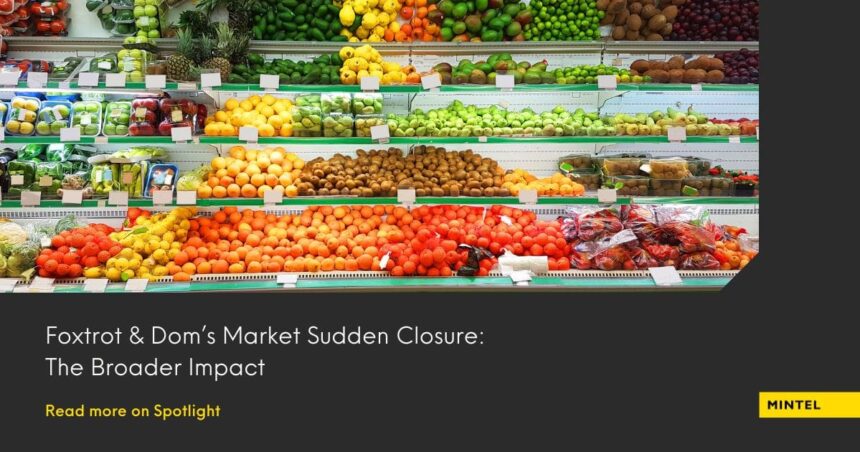On April 23, 2024, Chicago-based premium convenience stores Foxtrot Market and Dom’s Kitchen & Market permanently and abruptly closed all 35 locations with news of a Chapter 7 filing for bankruptcy. The news sent shockwaves through Chicago and other major cities. In recent years, Foxtrot expanded to new markets in Washington, D.C., Dallas and Austin and those locations saw their doors close as well.
The bankruptcy filing also comes after the merger of Foxtrot Market and Dom’s Kitchen & Market into Outfox Hospitality in November 2023, leaving many questions unanswered as to what went wrong.
As this story continues to unfold it’s clear more pieces of this puzzle will start to fit together, but it will ultimately leave lingering questions to what this means for broader trends in retail, food and beyond. In this piece, Mintel analysts across disciplines share perspectives on what this closure means for the larger concept of understanding consumer perception of value in 2024 and beyond.
The Challenge of Flexible Spaces
Diana Kelter, Associate Director of Consumer Trends
Foxtrot Market was designed with the intent to elevate the everyday, but that intention gradually took on many formats. The store catered to commuters or remote workers with on-premise coffee and seating areas. It promoted itself as being a place of discovery for new food items or drink brands. It was also an option for the spontaneous wine purchase or dinner party gift and that carried over into delivery services with various gift bundles promoted on the website. In essence, Foxtrot Market was modeling Mintel’s Consumer Trend Flexible Spaces. This trend speaks to public and private spaces taking on new uses to adapt to how consumers work, learn and socialize. The important element of the trend is that expansion has to occur without diluting the core purpose. On reflection, Foxtrot Market might have been excelling at flexibility, but it never really built a core purpose. Without a core purpose, it can be difficult to know where to streamline and where to expand. Consumers are still increasingly looking for unexpected value adds when they engage with spaces, but as everything increasingly becomes categorized as a lifestyle space, the need for a core identity is more important than ever.
Inflation Is Shifting What Consumers Value About Convenience
Jenny Zegler, Director, Mintel Food and Drink
The closure of Foxtrot Market and Dom’s Kitchen & Market reflects the inflation-induced reality in which today’s consumers are recalculating the value of convenience with a stronger emphasis on the actual price they pay, not just the figurative cost benefit of the time they save. Before the cost of living increased, Foxtrot and Dom’s delivered the value of convenience through carefully curated menu items and retail products that were premium and on-trend ̶ and thus worth a higher price than a traditional convenience store. Now that the economy has changed, recent Mintel research reveals that 62% of US convenience store visitors who live in urban areas want to cut back on shopping at convenience stores due to high prices. The closing of Foxtrot and Dom’s shows that operators of convenience retailers, especially those with city locations, need to carefully set fair prices for their enticing menu items and retail products that are easy to grab and go.
Foxtrot’s Marketing Misses Basket Math
Kaitlin Ceckowski, Associate Principal Consultant
Despite a limited marketing budget and media mix, Foxtrot’s entire brand identity functioned as its marketing. Their focus was on becoming a haven for “foodies.” The curation of unique, local, and hard-to-find items, combined with their “mind-blowing food” messaging, resonated with adventurous eaters. This clever brand positioning, notably achieved without a huge marketing spend, was undeniably effective. However, the focus on the extraordinary didn’t translate to everyday shopping needs. Customers came in for the occasional treat, not to fill their carts. This niche approach, while effective in attracting a specific clientele, limited repeat visits and basket sizes. Foxtrot’s marketing, though impactful, struggled to compete with routine, one-stop-shop destinations and retailers promoting value-centric bulk purchases.
Foxtrot Supported Small Brands. Its Departure Will Severely Affect Them.
Melanie Zanoza Bartelme, Associate Director, Mintel Food & Drink
Foxtrot was a hub for food and drink startups. Its foodie identity meant that the chain prioritized products that offered consumers something new and different, and such products lined its shelves and filled its freezers. While it’s still up for debate how well Foxtrot was doing financially, this kind of exposure is critical for growing brands. Now that Foxtrot has been suddenly removed as an option for brick-and-mortar placement, the brands that counted on Foxtrot will need to pivot, and quickly. This represents an opportunity for other retailers to absorb some of these brands and establish themselves as institutions that value innovation and ingenuity. It also puts incredible pressure on other emerging brands to compete for placement and could result in a growing number of small brands not being able to get onto shelves or having to rethink their strategies on the fly. For brands working to maximize every last bit of resources at their disposal, this could be a make-or-break moment.








